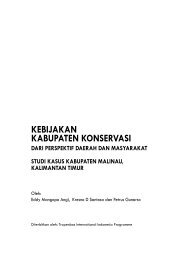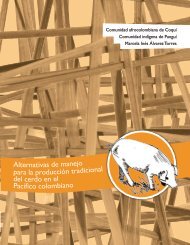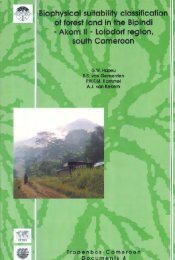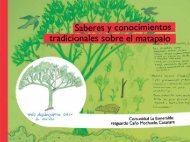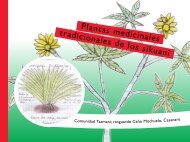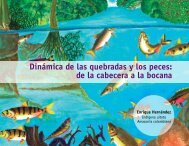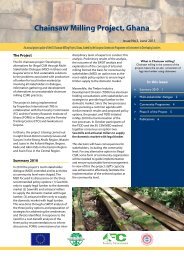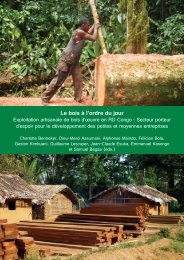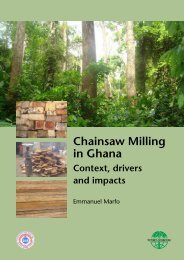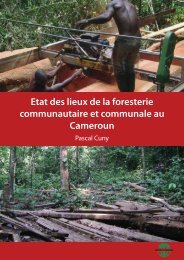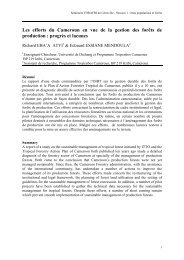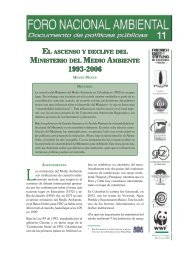Download the publication - Tropenbos International
Download the publication - Tropenbos International
Download the publication - Tropenbos International
Create successful ePaper yourself
Turn your PDF publications into a flip-book with our unique Google optimized e-Paper software.
General conclusions and implications for biodiversity conservation<br />
than 1% of herb diversity was explained by <strong>the</strong> tree diversity. The shrub layer was<br />
by far <strong>the</strong> most species rich in <strong>the</strong> different plots and vegetation types, and was<br />
significantly more diverse and species-rich than <strong>the</strong> tree and herbaceous layers.<br />
Moreover, shrubs contributed for 38% of <strong>the</strong> 114 strict and narrow endemic plant<br />
species recorded in <strong>the</strong> area, herbs (29%), trees (20%) and climbers (11%). These<br />
results indicated that in <strong>the</strong> context of African tropical rain forest, tree species<br />
diversity does not tell it all and <strong>the</strong>refore, it may not be a good indicator for <strong>the</strong><br />
diversity of shrubs and herbaceous species. Fur<strong>the</strong>rmore, this suggests that<br />
biodiversity survey based solely on large and medium sized tree species (DBH ≥ 10<br />
cm) is not an adequate method for <strong>the</strong> assessment of plant diversity because o<strong>the</strong>r<br />
growth form such as shrubs, climbers and herbs are under-represented. Inventory<br />
design based on small plots of 0.1 ha, in which all vascular plants with DBH ≥ 1 cm<br />
are recorded, is <strong>the</strong>refore, a more appropriate sampling method for biodiversity<br />
conservation purposes than assessments based solely on large and medium sized tree<br />
species.<br />
6.3. IMPLICATIONS FOR BIODIVERSITY CONSERVATION<br />
The Campo-Ma’an National Park<br />
The study has demonstrated that <strong>the</strong> park is of great scientific and conservation<br />
importance containing about 72% of <strong>the</strong> 2297 species of vascular plants, ferns and<br />
fern allies recorded in <strong>the</strong> Campo-Ma’an area and more than 70% of <strong>the</strong> total<br />
endemic species. The site’s conservation opportunities include a rich diversity of<br />
flora, fauna and habitats amongst which <strong>the</strong> most characteristic is <strong>the</strong> endemic<br />
lowland evergreen forest rich in Caesalpinioideae with Calpocalyx heitzii and<br />
Sacoglottis gabonensis that only occurs in <strong>the</strong> Campo area. So far <strong>the</strong> Park is <strong>the</strong><br />
only land use type in <strong>the</strong> area with a legal conservation status. It is fully protected by<br />
law, and logging, hunting, fishing, mineral exploitation, pastoral industrial,<br />
agricultural and forestry activities are forbidden. However, its boundaries have not<br />
been marked in <strong>the</strong> field, <strong>the</strong> management plan has not yet been produced,<br />
protection is weak and <strong>the</strong> participation of stakeholders in <strong>the</strong> management process<br />
is not operational. Taking into consideration <strong>the</strong> fact that <strong>the</strong> park is surrounded by<br />
several land-uses, its management needs to be streng<strong>the</strong>ned and coherent with that<br />
of o<strong>the</strong>r land-use types found in <strong>the</strong> area. Fur<strong>the</strong>rmore, it is of urgent need to<br />
demarcate <strong>the</strong> boundary of <strong>the</strong> park, reinforce its protection, complete and<br />
implement its management plan as soon as possible. Although <strong>the</strong> park is virtually<br />
free from human disturbance, present human influence is by no means negligible<br />
since illegal hunting is frequent. To allow effective control of poaching, several<br />
logging tracks and footpaths at <strong>the</strong> vicinity of <strong>the</strong> park need <strong>the</strong>refore to be closed,<br />
additional control posts should be established and more forest guards appointed.<br />
With its tremendous living genetic resources and its conservation status, <strong>the</strong> park is<br />
an ideal place for scientific research. Fur<strong>the</strong>r research is needed on <strong>the</strong> Dipikar<br />
Island and in areas east of Mvini’s river and Nkoelon to study <strong>the</strong> forest dynamics in<br />
disturbed lowland forest. This study will help to access <strong>the</strong> rate of forest recovery<br />
after logging in terms of plant species richness, forest structure and composition.<br />
Such research is needed because a better knowledge of <strong>the</strong> effect of human<br />
disturbance on <strong>the</strong> forest ecosystem is important for <strong>the</strong> development of sustainable<br />
119



